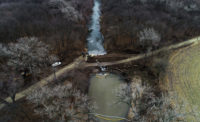Canada-based TC Energy said Dec. 30 that it has fully restarted the Keystone pipeline after a Dec. 7 rupture that spilled about 14,000 barrels, or more than 588,000 gallons, of crude oil into Mill Creek in Washington County, Kan., and sprayed nearby areas following an alarm and a drop in pressure.
After completing repairs, inspection, testing and a controlled restart of its affected extension to Cushing, Okla., the line is operating under plans approved by the U.S. Pipeline and Hazardous Materials Safety Administration, the Calgary company said in a statement.
Keystone is a 2,687-mile hazardous liquid pipeline system from Hardisty, Alberta to the U.S., where it splits in Nebraska into lines that continue east to Patoka, Ill. and south to Port Arthur, Texas. The line carries about 622,000 barrels per day from to Midwest and Gulf Coast refiners.
The line will operate with added risk-mitigation measures, including reduced operating pressure that must stay 20% below what it was when the spill happened, the federal agency said.
The pipeline normally operates under a higher pressure through a special federal permit granted it in 2017 that allowed it to save 10% on steel costs in using thinner but higher-grade steel, said a U.S. Government Accountability Office report in 2021.
TC Energy has not disclosed the line operating pressure at the time of the rupture.
“We recognize that incidents like this raise questions. We are committed to asking those tough questions, fully investigating and sharing our learnings and actions,” said Richard Prior, TC Energy president of liquids pipelines, in a statement.
There also was no update of the spilled oil cleaned up to date. It totaled about 7,600 barrels as of a Dec. 23 website update.
A company spokesperson told ENR that it used its own expertise and equipment for the spill response, but also hired third-party contractors to help with cleanup—also noting, on a post-rupture website, a crew that totaled more than 500 as of Dec. 30 but not releasing names of contractors.
“Due to confidentiality, we cannot disclose the names of our contractors. We appreciate the outreach we've had from a number of area specialists and are continuously assessing the needs of the response and will contract additional resources as necessary,” TC Energy said.
Vacuum trucks removed oil from the creek to control its spread. the firm said. Two earthen dams were built four miles downstream to contain spilled oil.
The spill is the largest in the pipeline's history and largest for a U.S. crude oil line in nearly a decade, said federal agencies.
The 36-in. dia., 288-mile southern extension was completed in 2011.
The corrective action issued by the pipeline agency also orders company submission of a root cause failure analysis within 90 days that must be “supplemented or facilitated” by an independent third-party. It also must include all factors contributing to the failure and any lessons learned and whether they are applicable to other locations within the company’s pipeline system.
House and Senate lawmakers also await responses by Jan. 4 to letters sent to TC Energy CEO Francois Poirier, asking whether the pipeline's higher operating pressure may have contributed to the latest rupture, and to two other major ones in 2017 and 2019. The Congressional queries also seek an estimate of the firm's costs for cleanup, repair and restoration operations related to the Kansas spill, as well as status of compensation agreements with affected landowners.
.







Post a comment to this article
Report Abusive Comment